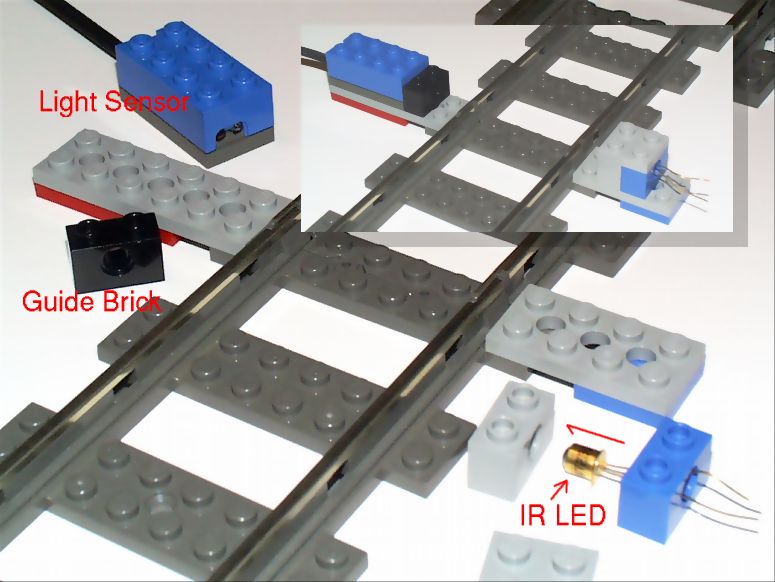LEGO 9v Train Axle Sensor
Questions on
lugnet.trains
and
lugnet.robotics
had me thinking about how to use the Mindstorms light sensor to read
barcodes. While I was working on that project, it occured to me that
the work I'd done on seeing dark and light stripes passing at variable
speeds could be applied to train axles.
The following sensor sits one plate height above the sleeper (and 1 stud
back, to avoid hitting passing trains). It uses a 1x2 technic beam as a
guide to aim the sensor directly across the track. This puts the sensor
just above the rails, but low enough that it can see underneath lowered
car bodies (like the Club Car). The only things that block it are wheels
and the entire motorized bogie. As a light source there is an IR LED
inside another 1x2 beam mounted at the same place on the opposite side of
the track. This IR LED is fairly directional already. When it's on, and
there is no car, the light sensor reads 70+. When a wheel is in the way
the sensor reads about 30. I think it would be possible to substitute a
standard 9v light here.

Using this sensor, the RCX can identify:
- single axles
- standard bogie plates (2 closely spaced axles)
- motorized bogie plates (blocks light across its entire body)
- fake motorized bogie plates (the idle wheels used in most engine designs,
slightly farther apart than a standard bogie)
From that, it can identify:
- engine going forward (fake motorized plate first, then motor. This is
backward from what the instructions call for
to ensure that a single axle and not a motor is at both ends of any train)
- engine going backward (motor first)
- fixed axle cars (2 widely spaced axles)
- long double-bogie cars (2 standard bogie plates)
NQC Source for RCX
You can download the source and play with this
yourself. The source describes the three functions which are called for
the various types of cars and names several cars from various sets which
satisfy the requirements.
This program can adapt to various train speeds and even accelerating and
decelerating trains.
This program can keep up with a train (one engine, several cars) going
up to speed 3 (on the control knob). At speed 4 its recognition is down
to about 80%, sometimes mistaking standard bogies for engines because
the RCX can't distinguish the small gap in the middle. If you need to
work at that speed you could fold the engine and double-bogie car detection
together and still count cars with 100% accuracy. I haven't tested much at
5 and 6, but it seems to be about the same as 4.
Future Plans
I'm still intrigued by the idea of adding barcodes to the bottoms of cars
and using the RCX to scan them and identify individual cars. The stock
firmware is not going to be fast enough to do this.
Other Designs
Another train detection device
was described and rendered by Ted Michon. It uses a touch sensor to detect the existance of a train.
![[Ben Jackson's Home]](../../bj2-icon.gif)
![[LEGO Raytracing Home]](../1708-house-icon.gif)
![[Mindstorm]](rcx-icon.jpg)

